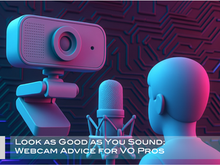Hey Voice Actors: Let’s Talk About Recording Levels and Why Normalizing Isn’t a Magic Fix
- Frank Verderosa
- Apr 28
- 3 min read

If you spend any time behind a microphone (and I know you do), you’ve probably heard the tip: “Don’t worry about your recording levels being low — you can just normalize later!” This often comes up with regards to lowering the audible noise level when recording. I get it — it sounds like an easy fix. But today I want to chat with you about why starting with low levels and relying on normalization can actually hurt your sound (why normalizing isn't a magic fix) — and what to do instead.
First, What Is Normalizing?
In simple terms, normalization boosts the loudest peak of your audio to a target level — usually something like -1 dB or -3 dB. It’s a quick way to make a file louder overall without “changing” anything else.
Sounds harmless, right?
Well… yes and no.
Why Recording Too Quietly Is a Problem, and Normalizing isn't a Magic Fix
When you record at a very low input level, you’re not just capturing your voice — you’re also capturing a ton of room noise and mic self-noise along with it. Later, when you normalize (or boost) that file, you’re not just turning up your lovely performance — you’re also turning up all that unwanted noise.
This can lead to:
Hiss and static becoming really noticeable
Weird background rumble or hum that wasn’t obvious at first
A thinner, less professional sound overall
Worse, if you try to “fix” the noise afterward with aggressive noise reduction, it can end up making your voice sound underwater, brittle, or robotic. Yikes!
Think of It Like Taking a Photo
When I try to describe a lot of audio issues, I find myself drawing digital photo comparisons. In this case, imagine you take a very dark photo and later crank up the brightness in editing. Sure, you can see more, but suddenly the image is grainy, full of noise, and looks way worse than if you had just taken the picture properly exposed. Audio works the same way. Starting with a strong, clean signal is everything.
So What Should You Do?
Aim for a healthy input level when you record.
Ideally, your voice should be peaking somewhere around -12 dB to -6 dB on your meter while recording.
This gives you a strong, clean signal without risking distortion if you get a little loud.

🎯 Watch your gain staging.
Use your preamp or interface gain control to set the right input level, not just the fader in your software afterward.
🎯 Use normalization as a polishing step, not a rescue mission.
After recording a good, strong take, then you can normalize (if needed) to match a specific delivery spec — like for ACX or a client — but you’ll be starting from a much better foundation.
Final Thought
You’ve worked too hard on your craft to let avoidable technical issues hold you back. A clean, strong recording makes editing easier, makes your voice shine, and makes you sound pro every time. So give yourself the gift of good levels from the start — future you (and your clients) will thank you.
And as always, if you need help checking your booth quality, setting levels and mic positioning, or want to learn best practices for when you need to remove noise in production- reach out to my via the website and we can schedule time to work together.




























Comments